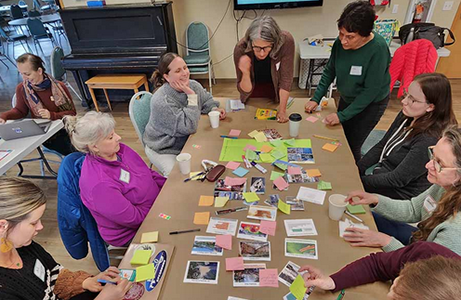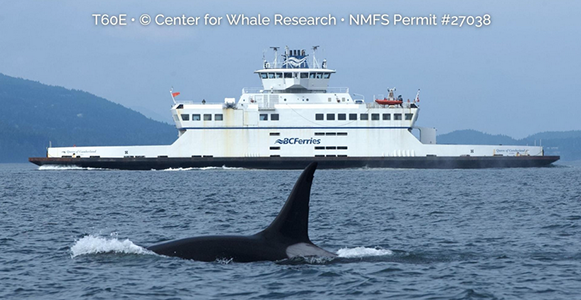On Wednesday, Oct. 21, Orcas County Council members Richard Fralick and Gene Knapp were joined by County Administrator Pete Rose and County Auditor Milene Henley at the Eastsound Fire Station to present “late-breaking news” and explanations of county actions regarding the budget, proposition #1 to increase property income tax, and updates to the Critical Areas Ordinance – shoreline and uplands portions.
The meeting also entertained questions from the audience and brief presentations by Paul Kamin, General Manager of the Eastsound Water Users Association and Kevin O’Brien, in support of the formation of an Orcas Island Park and Recreation District.
The late-breaking news was that the county has achieved compliance with the State Growth Management Act, which has long been sought in order to qualify for low-interest loans and grants; that general election ballots were printed with a mistake in return envelopes (sending the ballots to Asotin County); and that the County has made use of $75,000 in state and federal funds to address the H1N1 flu, including the current “second wave” and an “echo” expected next spring.
Island residents can call 211 for a flu hotline, or email www.sanjuanco.com/flu for updates.
Also of recent note is the County Council’s passage of a reserve policy, comprised of a 10 percent operating cash reserve, or approximately $1,200,000 this year; a 20 percent budget stabilization reserve fund and a Capital Reserve Fund of $25,000 this year.
This last fund will annually increase the amount set aside until it reaches $100,000.
Upon approving these reserve measures earlier this fall, the Council has required Administrator Rose to present a budget with the three funds included in it.
Henley spoke about the misaddressed ballot return envelopes, saying that her Elections Office is in daily contact with Asotin County, where the ballots were sent in error. Seven ballots that were sent to Asotin County by mistake have been re-sent to San Juan County Elections Office.
Council member Fralick, as head of the Council’s budget subcommittee, then addressed the continuing county budget crisis, showing figures indicating some $902,000 has been reduced from the county current expense budget. The only county department that hasn’t been cut is the one-person Board of Equalization, which had increased hours reflecting the increased property value increases.
The county’s revenue status, as of the end of September is down about 7.5 percent, and Henley projects that by year’s end, the decline will be close to 10 percent, or about $300,000.
Following the budget presentations, a question from Martha Farish brought out that county salaries and benefits equal about 72 percent of the current expense budget.
Tony Ghazel questioned the state’s tax collection policies, and Henley said that sales tax is now collected at the point of distribution, so that goods delivered to San Juan County are taxed at the San Juan County sales tax rate.
Proposition #1 to increase property taxes
Fralick related that the council has gone through four weeks of budget discussion realizing that, without an increase to county property tax revenue, next year’s budget will bring a shortfall from $800,000 to $1,200,000. “Mandated services are cut to the core,” Fralick said, and discretionary services are the “only area to cut back.”
With that likelihood, Fralick explained that the council “wants voters to tell us whether or not they’d be willing to pay for the property tax increase for discretionary services.”
That increase, of 12 cents for $1,000 assessed value, would cost the owner of a $500,000 property $60 per year.
Fralick emphasized that the increase is limited to a six-year term, and that revenues from the tax is earmarked proportionately for specific budget items.
Those earmarks include:
1. Senior Services on San Juan, Orcas, and Lopez Islands, at a cost of approximately $211,000;
2. WSU Extension programs, including 4-H, Master Gardeners and other volunteer and agricultural programs, at a cost of approximately $129,000;
3. Maintenance and operation of County parks, at a cost of approximately $200,000;
4. General fund support of the San Juan County Fair, at a cost of approximately $5,000;
5. Immunization clinics and public health services on San Juan, Orcas, and Lopez Islands, at a cost of approximately $112,000;
6. A Sheriff’s Department correctional officer restored to a full-time position, at a cost of approximately $42,000;
7. A deputy prosecuting attorney restored to a full-time position, at a cost of approximately $45,000;
8. The Department of Emergency Management manager funded out of the general fund, at a cost of approximately $50,000;
9. Reducing the number of days the County is closed for business, at a cost of approximately $140,000;
10. Maintenance o f County buildings and grounds, at a cost of approximately $18,000;
11. Protection of island waters by funding the maintenance of Islands’ Oil Spill Association emergency response equipment, at a cost of $8,000.
$112,000 for Senior Services and $200,000 for County Parks
The Council has prepared two 2010 budgets, one accounting for voter approval of proposition #1’s tax increase, and the other to go into effect if the tax increase does not meet voter approval.
A discussion of the current County Parks funding and the creation of a separate Park and Recreation District for Orcas Island followed. (See “Orcas Votes on Creating its own Park and Recreation District” to follow this article)
Shoreline and Uplands Critical Areas Updates
The scheduled 2006 Critical Areas Ordinance(CAO) update has been complicated by the 2008 state Supreme Court decision “the Anacortes Decision” — stating that shoreline critical environmental protection areas should be governed by the Shoreline Management Act rather than the Growth Management Act.
With this decision, the San Juna Council decided to proceed with the uplands portion of the CAO update. “We won’t be moving on the shoreline track as fast as on teh uplands portion,” Fralick said.
“Field trips” to examine the Orcas Island (primarily Eastsound) wetlands are scheduled for 11 a.m. on Nov. 12. Discussions will follow that day at 5 p.m., facilitated by the San Juan Initiative.
It is expected that the Planning Commission will hold public hearings regarding the uplands ordinance after the first of the new year, and then the ordinance will proceed to the County Council.
The Shoreline Master Plan, the governing document relating to Shoreline Critical Areas, will begin the update process with a $450,000 grant from the State Department of Ecology. It is expected that the county will receive $180,000 in 2010 to begin that work, to be completed in December 2012.
Patty Miller, Eastsound Planning Review Committee and CAO Update Committee member, advised interested citizens to read a 20-page paper written by the San Juan Initiative which will be available on the county website, www.sanjuanco.com next week, prior to attending the Nov. 12 workshops.
Former County Commissioner and San Juan Builders Association President John Evans said that new regulations on uplands and shorelines will “create thousands of non-conforming uses on parcels,” which will create “significant issues for San Juan County ecoomy.” He added that the tax base will be affected: “If buffers are established as currently planned, there will be very little land left for development in Eastsound.”
Evans advised considering the “local option in state laws … so that parcels can remain perfectly legal.”
Janet Alderton, Deer Harbor ecologist emphasized the need to “move along on shoreline protection” as many substances being released into local waters contain “toxic, long-lasting substances.”
Eastsound property owner Martha Farish spoke on behalf of using local scientific studies, such as ones conducted by SeaDoc and KWAIHT, “that are correlated to what we see in the UGA.”
Fralick said, “I urge you, plead with you, to participate i the public process. This is your opportunity to get your say.”
Knapp said that part of the “cause of the turmoil is the Supreme Court couldn’t agree on the Anacortes decision,” in giving legal advice to counties and towns. “No one knows what it means,” Knapp said, adding that two appellate courts couldn’t agree on the law.
1. Senior Services on San Juan, Orcas, and Lopez Islands, at a cost of approximately $211,000;
2. WSU Extension programs, including 4-H, Master Gardeners and other volunteer and agricultural programs, at a cost of approximately $129,000;
3. Maintenance and operation of County parks, at a cost of approximately $200,000;
4. General fund support of the San Juan County Fair, at a cost of approximately $5,000;
5. Immunization clinics and public health services on San Juan, Orcas, and Lopez Islands, at a cost of approximately $112,000;
6. A Sheriff’s Department correctional officer restored to a full-time position, at a cost of approximately $42,000;
7. A deputy prosecuting attorney restored to a full-time position, at a cost of approximately $45,000;
8. The Department of Emergency Management manager funded out of the general fund, at a cost of approximately $50,000;
9. Reducing the number of days the County is closed for business, at a cost of approximately $140,000;
10. Maintenance o f County buildings and grounds, at a cost of approximately $18,000;
11. Protection of island waters by funding the maintenance of Islands’ Oil Spill Association emergency response equipment, at a cost of $8,000.
**If you are reading theOrcasonian for free, thank your fellow islanders. If you would like to support theOrcasonian CLICK HERE to set your modestly-priced, voluntary subscription. Otherwise, no worries; we’re happy to share with you.**







